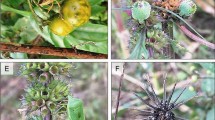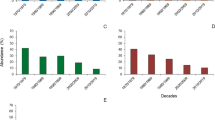Abstract
Canola (Brassicaceae: Brassica spp.) is an important feedstock for biodiesel production and a potential ingredient for use in the food industry. In different continents, various arthropod pests damage canola plants. Stink bugs (Heteroptera: Pentatomidae) are present in all zoogeographical regions, and many species are recognized by their economic importance as crop pests. Our aim was to describe the composition, structure, and diversity of the assemblage of stink bugs sampled on canola in southern Brazil. A total of 878 pentatomids were captured, belonging to 27 species. The dominant species were Euschistus heros (F.) (n = 439), Dichelops furcatus (F.) (n = 160), and Nezara viridula L. (n = 79). The species richness estimators indicated the samples correspond from 79.7 to 93.1% of the richness estimated. Comparing canola to other monocultures, the richness of Pentatomidae was much superior. Otherwise, when compared to studies conducted in native vegetation and urban fragments, the richness is similar, and sometimes higher. This relatively high number of associations brings out the vulnerability of the canola fields according to the expansion of its cultivated area. Nine species of Pentatomidae are recorded on canola for the first time in Brazil. The most abundant species reported here are often stressed as stink bugs of economic importance in agro-ecosystems. The economic importance of each species varies greatly depending on the plant attacked. Detailed studies are needed to evaluate the damage caused to canola by stink bugs.


Similar content being viewed by others
References
Aider M, Barbana C (2011) Canola proteins: composition, extraction, functional properties, bioactivity, applications as a food ingredient and allergenicity-a practical and critical review. Trends Food Sci Technol 22:21–39
Alvares CA, Stape JZ, Sentelga PC, de Moraes Gonçalves JL, Sparovek G (2013) Köppen’s climate classification map for Brazil. Meteorol Z 22:711–728
Arizona Agricultural Statistics (2011) Arizona Agricultural Statistics Bulletin. United States Department of Agriculture, National Agricultural Statistics Service, Beltsville http://www.nass.usda.gov/Statistics_by_State/Arizona/Publications/Bulletin/11bul/main.html. Accessed 12 Apr 2018
Bergmann JC, Tupinambá DD, Costa OYA, Almeida JRM, Barreto CC, Quirino BF (2013) Biodiesel production in Brazil and alternative biomass feedstocks. Renew Sust Energ Rev 21:411–420
Bianchi FM, Mendonça MS, Campos LA (2014) Comparing vegetation types and anthropic disturbance levels in the Atlantic forest: how do Pentatomoidea (Hemiptera: Heteroptera) assemblages respond? Environ Entomol 43:1507–1513
Bianchi FM, Deprá M, Ferrari A, Grazia J, Valente VL, Campos LA (2017) Total evidence phylogenetic analysis and reclassification of Euschistus Dallas within Carpocorini (Hemiptera: Pentatomidae: Pentatominae). Syst Entomol 42:399–409
Campos LA, Bertolin TBP, Teixeira RA, Martins FS (2009) Diversidade de Pentatomoidea (Hemiptera, Heteroptera) em três fragmentos de Mata Atlântica no sul de Santa Catarina. Iheringia Sér Zool 99:165–171
CANOLA GROWER’S MANUAL (2018) Chapter 10B – Insects. https://www.canolacouncil.org/canola-encyclopedia/insects/. Accessed 11 Mar 2018
CDFA (2012) California agricultural statistics review, 2011–2012, vegetable and melon crops. California Department of Food and Agriculture, Sacramento https://www.cdfa.ca.gov/Statistics/PDFs/ResourceDirectory_2011-2012.pdf. Accessed 12 Apr 2018
Colwell RK (2006) EstimateS: statistical estimation of species richness and shared species from simples, version 8.0. http://purl.oclc.org/estimates. Accessed 22 Jan 2018
CONAB (2018) Acompanhamento da safra brasileira de grãos, v. 7, Safra 2017/18, Sétimo levantamento, Brasília, p. 1–139 https://www.conab.gov.br/index.php/component/k2/item/download/15981_1bf16b30fedc35f1da5494e55bd32ac8. Accessed 15 Apr 2018
Corrêa-Ferreira BS, De Azevedo J (2002) Soybean seed damage by different species of stink bugs. Agric For Entomol 4:145–150
Demirel N (2009) Determination of heteroptera species on canola plants in Hatay province of Turkey. Afr J Agric Res 4:1226–1233
Dias JCA (1992) Canola/colza: alternativa de inverno com perspectiva de produção de óleo comestível e energético. EMBRAPA-CPATB, Pelotas, p 46
Faúndez EI, Luer A, Cuevas AG (2017) The establishment of Bagrada hilaris (Burmeister, 1835) (Heteroptera: Pentatomidae) in Chile, an avoidable situation? Arq Entomolóxicos 17:239–241
Firmino JV, Mendonça MD, Lima IM, Grazia J (2017) Pentatomidae (Hemiptera: Heteroptera) in herbaceous and shrub strata of Atlantic Forest remnants in northeastern Brazil. Environ Entomol 46:480–486
Gonçalves WM, Maluf WR, Resende LV, Sarmiento CM, Licursi V, Moretto P (2017) Energy balance of biodiesel production from canola. Cienc Rural 47:e20151084. https://doi.org/10.1590/0103-8478cr20151084
Grazia J, Panizzi AR, Greve C, Schwertner CF, Campos LA, Garbelotto TDA, Fernandes JAM (2015a) Stink bugs (Pentatomidae). In: Panizzi AR, Grazia J (eds) True bugs (Heteroptera) of the Neotropics. Springer, Netherlands, pp 681–756
Grazia J, Simões FL, Panizzi AR (2015b) Morphology, ontogeny, reproduction, and feeding of true bugs. In: Panizzi AR, Grazia J (eds) True bugs (Heteroptera) of the Neotropics. Springer, Netherlands, pp 21–55
Gu H, Fitt GP, Baker GH (2007) Invertebrate pests of canola and their management in Australia: a review. Austral Entomol 46:231–243
Hammer Ø, Harper DAT, Ryan PD (2001) PAST: Palaeontological statistics software package for education and data analysis. Palaeontol Electron 4:1–9
IBGE (2004) Indicadores Agropecuários 1996–2003 https://ww2.ibge.gov.br/home/estatistica/economia/agropecuaria/indicadoresagro_19961996/default.shtm. Accessed 30 Jan 2018
Klein JT, Redaelli LR, Barcellos A (2013) Andropogon bicornis (Poales, Poaceae): a hibernation site for Pentatomoidea (Hemiptera: Heteroptera) in a rice-growing region of Southern Brazil. Neotrop Entomol 42:240–245
Kogan M, Turnipseed SG (1987) Ecology and management of soybean arthropods. Annu Rev Entomol 32:507–538
Krebs CJ (1989) Ecological methodology. Harper & Row, New York, p 654
Magurran A (1988) Ecological diversity and its measurement. British Library, Cambridge, p 177
Marsaro Júnior AL, Panizzi AR, Pereira PRVS, Grazia J, Bianchi FM, Scarparo AP (2017) Percevejos (Heteroptera) fitófagos e predadores associados à cultura da canola no norte do estado do Rio Grande do Sul. Embrapa Trigo, Passo Fundo http://ainfo.cnptia.embrapa.br/digital/bitstream/item/161014/1/ID44057-2017DO167.pdf. Accessed 22 Mar 2018
Mendonça MS, Schwertner CF, Grazia J (2009) Diversity of Pentatomoidea (Hemiptera) in riparian forests of southern Brazil: taller forests, more bugs. Rev Bras Entomol 53:121–127
Palumbo JC, Perring TM, Millar JG, Reed DA (2016) Biology, ecology, and management of an invasive stink bug, Bagrada hilaris, in North America. Annu Rev Entomol 61:453–473
Panizzi AR (1997) Wild hosts of pentatomids: ecological significance and role in their pest status on crops. Annu Rev Entomol 42:99–122
Panizzi AR (2013) History and contemporary perspectives of the integrated pest management of soybean in Brazil. Neotrop Entomol 42:119–127
Panizzi AR (2015) Growing problems with stink bugs (Hemiptera: Heteroptera: Pentatomidae): species invasive to the US and potential neotropical invaders. Am Entomol 61:223–233
Panizzi AR, McPherson JE, James DG, Javahery M, McPherson RM (2000) Sting bugs (Pentatomidae). In: Schaefer CW, Panizzi AR (eds) Heteroptera of economic importance. CRC Press, Boca Raton, pp 421–474
Raymer PL (2002) Canola: an emerging oilseed crop. In: Janick J, Whipkey A (eds) Trends in new crops and new uses. ASHA Press, Alexandria, pp 122–126
Reay-Jones FPF (2010) Spatial and temporal patterns of stink bugs (Hemiptera: Pentatomidae) in wheat. Environ Entomol 39:944–955
Reeves RB, Greene JK, Reay-Jones FPF, Toews MD, Gerard PD (2010) Effects of adjacent habitat on populations of stink bugs (Heteroptera: Pentatomidae) in cotton as part of a variable agricultural landscape in South Carolina. Environ Entomol 39:1420–1427
Schmidt LS, Barcellos A (2007) Abundância e riqueza de Heteroptera (Hemiptera) do Parque Estadual do Turvo, sul do Brasil: Pentatomoidea. Iheringia, Sér Zool 97:73–79
Schwertner CF, Grazia J (2007) O gênero Chinavia Orian (Hemiptera, Pentatomidae, Pentatominae) no Brasil, com chave pictórica para os adultos. Rev Bras Entomol 51:416–435
Shahidi F (1990) Canola and rapeseed: production, chemistry, nutrition, and processing technology. Van Nostrand, Springer Science & Business Media, p 355
Smaniotto LF, Panizzi AR (2015) Interactions of selected species of stink bugs (Hemiptera: Heteroptera: Pentatomidae) from leguminous crops with plants in the Neotropics. Fla Entomol 98:7–17
Soria MF, Degrande PE, Panizzi AR, Toews MD (2017) Economic injury level of the Neotropical brown stink bug Euschistus heros (F.) on cotton plants. Neotrop Entomol 46:324–335
Tindall KV, Williams BJ, Stout MJ, Geaghan JP, Leonard BR, Webster EP (2005) Yield components and quality of rice in response to graminaceous weed density and rice stink bug populations. Crop Prot 24:991–998
Tomm GO, Wietholter S, Dalmago GA, Santos HP (2009) Tecnologia para produção de canola no Rio Grande do Sul. Embrapa Trigo, Passo Fundo, RS, Documentos 92, p 88
Tomm GO, Marsaro Júnior AL, Pereira PRVS, Salvadori JR (2014) Insetos In: Tomm GO (ed.) Cultivo da canola, 2 edn. Brasília, DF: Embrapa Informação Tecnológica, 2014 (Sistema de produção, 3). Accessed 22 Mar 2018
USDA (2017) Canola https://www.ers.usda.gov/topics/crops/soybeans-oil-crops/canola/. Accessed 17 Apr 2018
Weiler L, Ferrari A, Grazia J (2016) Phylogeny and biogeography of the South American subgenus Euschistus (Lycipta) Stål (Heteroptera: Pentatomidae: Carpocorini). Insect Syst Evol 47:313–346
Acknowledgments
This work was supported by a grant to ALMJ and PRVSP from Embrapa through the project Manejo da entomofauna na cultura da canola FMB was supported by a fellowship from the Coordenação de Aperfeiçoamento de Pessoal de Nível Superior CAPES-PNPD, Ministry of Education, Brazil. JG was supported by a fellowship from the Conselho Nacional de Desenvolvimento Científico e Tecnológico – CNPq (PQ#305009/2015-0). ARP was supported by a grant from the Conselho Nacional de Desenvolvimento Científico e Tecnológico – CNPq (PQ#400551/2016-0).
Author information
Authors and Affiliations
Contributions
ALMJ, PRVSP, and ARP planned, designed, and executed field work; FMB and JG made the taxa identification; FMB analyzed the data; FMB and ALMJ wrote the first draft; all authors contributed to the final version of the paper.
Corresponding author
Additional information
Edited by Edison Ryoiti Sujii – Embrapa/Cernagen
Rights and permissions
About this article
Cite this article
Bianchi, F.M., Marsaro Júnior, A.L., Grazia, J. et al. Diversity of Stink Bugs (Pentatomidae) Associated with Canola: Looking for Potential Pests. Neotrop Entomol 48, 219–224 (2019). https://doi.org/10.1007/s13744-018-0642-3
Received:
Accepted:
Published:
Issue Date:
DOI: https://doi.org/10.1007/s13744-018-0642-3




